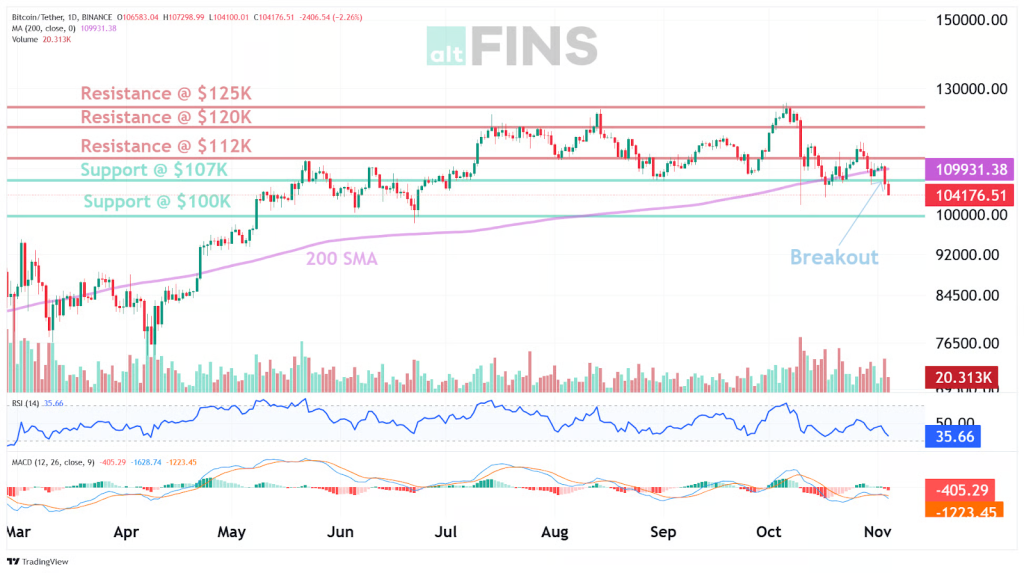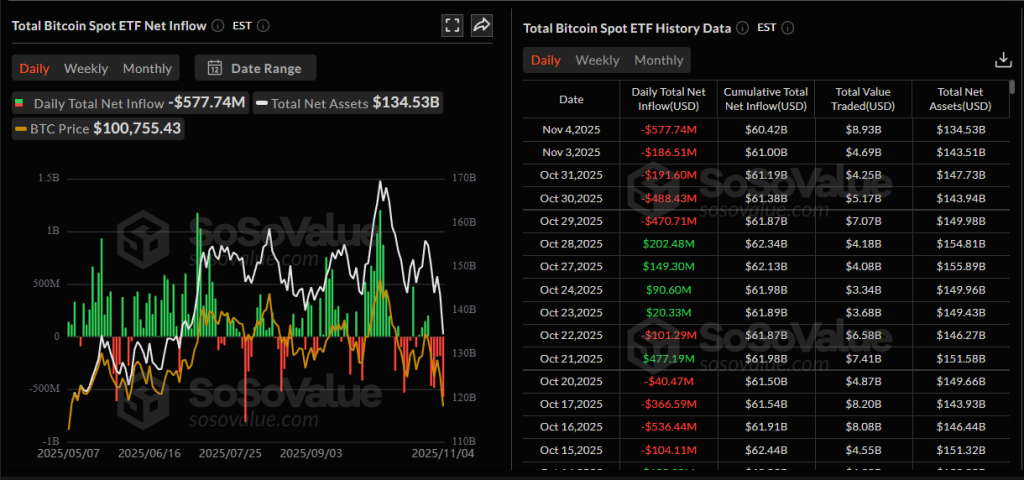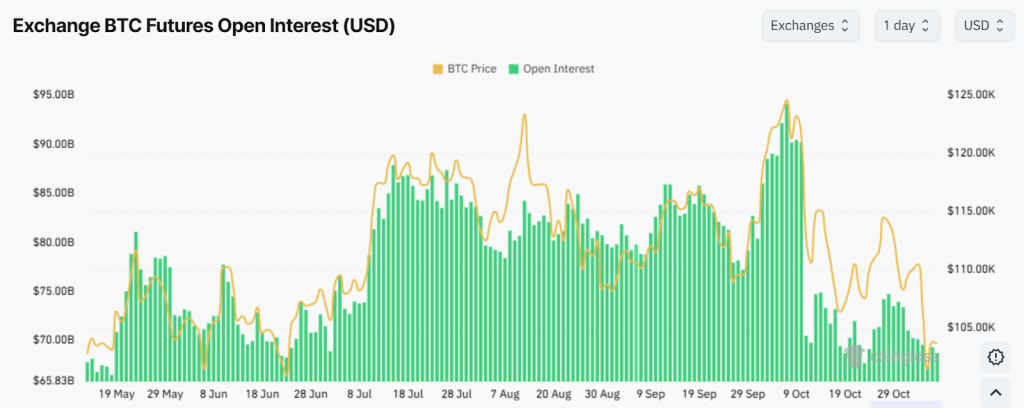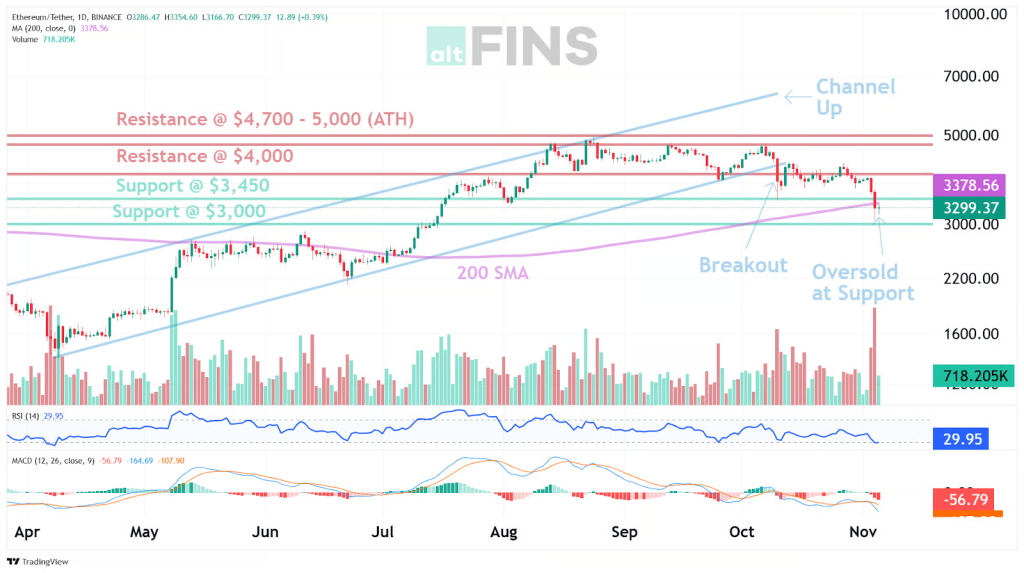BTC Lost Upside Momentum
6th November 2025 • 9mins read
This Week’s Recap
- Bitcoin Plunges Below $100,000 for First Time Since June as Correction Deepens: Bitcoin dipped under $100,000 on major exchanges before rebounding slightly. The move capped a near 20% drawdown from the October record and coincided with broader risk-off flows. Traders flagged the $100,000 level as key psychological support to watch next.
- Spot Bitcoin ETFs See Five-Day, $1.9 Billion Outflow Streak: U.S. spot Bitcoin ETFs recorded $566.4 million in net redemptions on Tuesday, bringing five-day outflows to roughly $1.9 billion. Fidelity’s FBTC led the exits, with ARKB and GBTC also posting sizable redemptions. Persistent outflows reinforced the risk-off tone around BTC near $100,000.
- Ether’s 20% Slide Triggers About $1 Billion in Liquidations: Ether fell more than 20% over two days, sparking nearly $1 billion in derivatives liquidations. Analysts warned of potential tests toward $2,700 to $2,800 if flows and risk appetite remain weak. The drawdown underscored deleveraging pressure across majors.
- Ripple Raises $500 Million at a $40 Billion Valuation: Ripple secured $500 million from investors including Fortress Investment and Citadel Securities, keeping its valuation at $40 billion. The raise follows a recent $1 billion tender offer and expands funding for stablecoin, custody, and brokerage initiatives. Management framed the round as validation of growing institutional demand for blockchain payments.
- Ripple and Mastercard Pilot RLUSD Settlements on XRP Ledger: Ripple, Mastercard, WebBank, and Gemini are piloting credit-card settlement using RLUSD on a public blockchain. The test could mark one of the first times a regulated U.S. bank settles fiat card payments with a stablecoin on a public network. RLUSD circulation has surpassed $1 billion under New York trust oversight.
- Over $1.3 Billion in Crypto Positions Liquidated as BTC Slips Under $104,000: A market slide pushed Bitcoin to an intraday low near $103,860, triggering about $1.3 to $1.4 billion in liquidations. Altcoins fell alongside BTC, taking total crypto market capitalization lower. The episode highlighted fragile positioning amid ETF outflows and macro uncertainty.
- Galaxy Trims Year-End Bitcoin Target to $120,000: Galaxy Digital cut its 2025 year-end BTC target from $185,000 to $120,000. The research note cited whale selling, AI-driven capital competition, and rising gold demand as headwinds. The revision feeds a more cautious institutional outlook into year-end.
- Robinhood’s Crypto Trading Revenue Jumps 339% to $268 Million in Q3: Robinhood reported a surge in crypto revenue to $268 million, with $80 billion in crypto volume during the quarter. Shares dipped post-print despite the beat, though remain up year-to-date. Management highlighted product expansion, including prediction markets and the Bitstamp deal.
- Zcash Overtakes Monero by Market Cap, Signaling Privacy-Coin Power Shift: Zcash’s market cap climbed to about $7.2 billion, surpassing Monero near $6.3 billion. The flip reflects shifting views on privacy design and compliance across exchanges. Analysts flagged the theme as a relative winner during ETF-driven rotations.
- European Commission Weighs SEC-Style Single Supervisor for Exchanges: The EU is preparing proposals to centralize oversight of stock and crypto exchanges, potentially expanding ESMA’s powers. Supporters argue a single supervisor would cut fragmentation and boost competitiveness. Smaller states warn of higher compliance costs and reduced local autonomy.
- ‘Big time debut’: U.S. spot Solana ETFs draw $200 million in first week: U.S. spot Solana ETFs attracted about $200 million during a short debut week, led by Bitwise’s BSOL. First day inflows topped $69 million, with cumulative flows building across the week. The launch broadens crypto ETF exposure beyond Bitcoin and Ethereum.
- Tether profits top $10 billion for the first nine months, starts buyback program: Tether reported more than $10 billion in net profit year to date and launched a share buyback. The stablecoin issuer also disclosed holdings in gold and Bitcoin alongside large U.S. Treasury exposure. Management is pursuing an investment fund license in El Salvador. (CoinDesk)
- Ethereum devs officially target December 3 for Fusaka upgrade: After final testnet deployments, core developers set December 3 as the mainnet date. Fusaka includes PeerDAS to cut data costs for rollups and improve L2 economics. The upgrade is positioned to reduce fees and support modular scaling.
Bitcoin Market Analysis
BTC traded in a wide band this week, ranging between 111,230 and 99,002, then stabilizing near 103,900. The move represents a decline of roughly 6 to 7 percent from the prior week and extends the drawdown from the October peak to about 18 to 20 percent. A series of lower daily highs and an intraday low below 100,000 signaled stress around prior demand zones. Price discovery appears to have shifted from momentum driven behavior to liquidity seeking behavior, which favors two-sided trading until a decisive break or reclaim develops.

Source: https://altfins.com/technical-analysis
The technical backdrop deteriorated after the loss of the 200-day simple moving average near 109,900 alongside expanding true range, while MACD remained below its signal and RSI hovered in the mid-30s. This configuration is commonly associated with downside persistence unless strong reclamations occur, particularly when volatility expands following a failed breakout. The confluence of a broken channel base at 108,000 to 107,000 and a slip below the 200-day average indicates that supply is still active on rallies. Momentum remains negative, though not yet exhausted, leaving room for either a continuation leg or a reflexive bounce, contingent on flows.
Key levels are defined with supports at 102,000 to 100,000, then 97,200, 95,000, and 92,000, and resistances at 107,000, 111,800 to 112,500, 120,000, and 125,000. A daily acceptance below 100,000 has historically unlocked faster moves toward 95,000 and 92,000, while a 4-hour close back above 107,000 has often preceded tests of 111,800 and 120,000. The base case favors consolidation between 100,000 and 107,000 unless catalysts shift the balance. Invalidations should be kept tight around 102,200 on breakdown setups and around 105,200 on reclaim attempts, given current volatility.
Spot ETF activity showed a five-day net outflow streak of about 1,900,000,000, including a single-day redemption near 577,700,000, while cumulative net inflow stood around 60,400,000,000 and total net assets near 143,500,000,000. The flow profile coincided with failed attempts to reclaim 107,000 and with softer intraday bounces around 100,000, implying that the marginal spot buyer turned net seller during the slide. Historically, a more constructive regime has followed when two or more consecutive positive flow days appear with at least one daily print above 300,000,000. Sustained positive prints will likely be required before durability is assigned to any upside reclaim.

Source: https://sosovalue.com/assets/etf/us-btc-spot
Liquidity conditions show evidence of post deleveraging, as exchange BTC futures open interest has retraced and remains below recent peaks while price dipped toward 100,000. This setup often reduces follow through on countertrend rallies because less leverage is available to extend bounces. A constructive shift would first appear as stabilization or a measured rebuild in open interest alongside rising spot participation.

Source: https://www.coinglass.com/BitcoinOpenInterest
Macro conditions were mixed, not uniformly risk off. Global equities pulled back from record or near record levels as investors questioned rich AI valuations, yet AI leaders remain elevated on a multi-month view. Multiple outlets reported declines across the United States, Europe, and Asia tied to profit taking and valuation concerns, while volatility picked up. The dollar firmed as near term rate cut expectations were reduced, a backdrop that often tightens financial conditions for high beta, non-yielding assets. MUFG and Reuters noted the dollar index rising back above 100, while gold weakened into this mix, with reports of a one day slide around November 4 followed by partial stabilization. These moves constrained risk budgets even as AI heavy equities stayed high in context. The balance of evidence supports the view that AI stocks remain elevated while gold softened, and it frames 100,000 as a practical pivot for BTC until incoming data clarify policy and growth.
Bottom line, the path of least resistance remains lower toward 97,200 to 95,000 unless 107,000 is reclaimed alongside a visible improvement in ETF flows. In the near term, respect the 100,000 to 102,000 support band and the 105,200 to 107,000 reclaim zone as the operational pivot. For confirmation, monitor the direction and magnitude of daily ETF net flows, intraday liquidation totals, funding skew, and whether spot demand leads rebounds. If two or more consecutive positive ETF flow days appear, with at least one day above 300,000,000, the probability of tests toward 111,800 and 120,000 increases.
Ethereum Market Analysis
Ether declined sharply this week, closing near 3,430 to 3,447 on Nov 6 after reaching a weekly high around 3,916 on Nov 2 and a weekly low near 3,060 on Nov 4. Daily prints across Oct 31 to Nov 6 align with 3,848, 3,875, 3,908, 3,604, 3,289, 3,425, and about 3,43x to 3,45x on Nov 6, which defines an 856 range and a two-day drawdown of more than 20 percent into the Nov 4 trough. This sequence captured a clear break from the prior consolidation followed by a quick rebound attempt. The pattern is consistent with a deleveraging shock followed by stabilization inside a still fragile range.

Source: https://altfins.com/technical-analysis
Technically, price sits below the 20, 50, and 100-day moving averages, and it slipped under the 200-day average during the decline, confirming deterioration in trend structure. Daily RSI hovered near 30 at the lows, a level often associated with reflex bounces without changing the dominant downtrend. Independent technical commentary around Nov 4 also flagged the break of major averages and a turn to defensive momentum. In synthesis, momentum is weak enough to allow mean reversion, yet trend signals remain bearish enough to cap rallies below short-term moving averages.
Key levels remain well defined by the break and recoil. Immediate support sits at 3,000, with a failure there opening risk toward 2,800 to 2,700 in line with the depth of the liquidation flush. Overhead, 3,450 is the first retest gate, followed by 4,000 as a pivotal area where supply has repeatedly emerged, with 4,700 to 5,000 reserved for a materially improved regime. A daily close back above 3,450 would neutralize the breakdown and set a path to probe 4,000, while rejection below 3,450 would keep the path of least resistance lower.
Spot ETF flows weakened into early November. Multiple trackers report a five-day streak of net outflows ending Nov 4, when U.S. spot ETH ETFs saw about 219,000,000 in redemptions, led by withdrawals from large funds, and summaries note total ETH ETF net assets near 21,100,000,000 around that date. The directional link is that price declined alongside a negative flow impulse, so a durable recovery likely requires at least a halt to redemptions and a return to flat or modestly positive daily prints. Issuer-level breakdowns attribute the largest single-day withdrawals to the largest funds.

Derivatives dynamics reinforced the move. CoinDesk, citing CoinGlass, reported more than 1,000,000,000 in leveraged liquidations across crypto as the slide accelerated, with long positions comprising the bulk, which helps explain the swift breach of 3,450 and the 200-day before stabilization. Until funding, basis, and dealer positioning turn decisively constructive, rally attempts are best treated as reactive retracements rather than evidence of a resumed uptrend. The practical takeaway is that durable upside requires cleaner positioning and steadier spot and ETF demand, not only technical oversold readings.
Near-term guidance favors disciplined reaction to levels rather than anticipation. Bounces into 3,450 and 4,000 should be evaluated for evidence of follow-through breadth, while downside tests of 3,000 require vigilance for renewed forced selling. A daily close back above the 20-day moving average would shift the bias from sell-rallies to buy-the-dip, whereas continued ETF outflows would keep 3,000 vulnerable and leave 2,800 to 2,700 in play. In summary, conditions remain tactically oversold, structurally cautious, and flow dependent, with conviction reserved for signals that show stabilization in ETF prints and momentum reclaiming short-term trend.
Mark Your Calendars
Economic Data Releases:
- November 7, 2025 (Friday): U.S. Unemployment Rate
- November 13, 2025 (Thursday): Consumer price index
- November 13, 2025 (Thursday): Core CPI
- November 14, 2025 (Friday): Producer price index
- November 14, 2025 (Friday): Core PPI
Token Unlock
- November 10, 2025 (Monday): LINEA (LINEA) unlocks $35.53 M (16.44 % of market cap)
- November 11, 2025 (Tuesday): APT (APT) unlocks $33.37 M (1.06 % of market cap)
- November 13, 2025 (Thursday): AVAX (AVAX) unlocks $39.43 M (0.46 % of market cap)
- November 13, 2025 (Thursday): CHEEL (CHEEL) unlocks $13.36 M (2.95 % of market cap)
